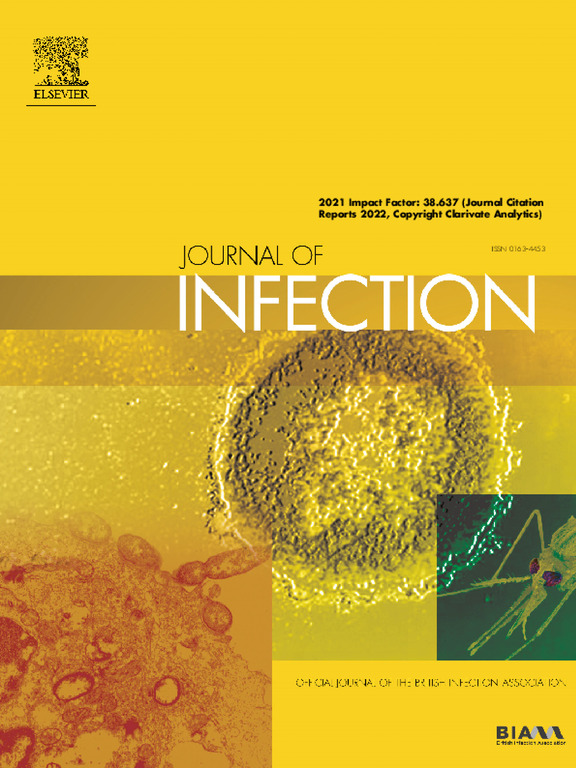在加泰罗尼亚(2023-2024)实施尼西维单抗免疫预防后HRSV的进化动力学。
IF 11.9
1区 医学
Q1 INFECTIOUS DISEASES
引用次数: 0
摘要
目的:通过分析来自未免疫和先前免疫患者的病毒的突变、多样性和进化动力学,评估nirsevimab施加的选择压力对加泰罗尼亚(2023-2024)人类呼吸道合胞病毒(HRSV)的影响。方法:通过加泰罗尼亚SIVIC哨点网络和三家医院采集呼吸样本。对hrv阳性样本进行全基因组测序(WGS),或在无法进行全基因组测序时进行F基因测序。评估了病毒多样性、系统发育和选择压力。结果:WGS共251例(hrsva: 165例;HRSV-B: 86)和27F基因序列(HRSV-A: 13;未免疫组HRSV-B: 14)。在免疫病例中,79例WGS (hrsva: 67;HRSV-B: 12)和12F序列(HRSV-A: 10;HRSV-B: 2)。两组之间的血统分布保持相似。尽管免疫的HRSV-B组核苷酸多样性有所减少,但HRSV-A组的核苷酸多样性相似。选择压力表明免疫样本向中性进化转变。在nirsevimab表位中检测到突变N63S、K65R、I206T和K209E (hrv - a)和突变K68E、R209Q和S211N (hrv - b),未免疫样品中不存在K209E和K68E。结论:尼瑟维单抗免疫接种可能影响HRSV的进化,特别是在HRSV- b中。持续的基因组监测对于早期发现耐单抗突变体至关重要。本文章由计算机程序翻译,如有差异,请以英文原文为准。
Evolutionary dynamics of HRSV following the implementation of nirsevimab immunoprophylaxis in Catalonia (2023-2024)
Objectives
To evaluate the effect of the selective pressure exerted by nirsevimab on human respiratory syncytial virus (HRSV) in Catalonia (2023–2024) by analysing viral mutations, diversity, and evolutionary dynamics, based on viruses characterised from non-immunised and previously immunised patients.
Methods
Respiratory samples were collected through the SIVIC sentinel network and three hospitals in Catalonia. HRSV-positive samples underwent whole-genome sequencing (WGS), or F gene sequencing when WGS was not feasible. Viral diversity, phylogenetics, and selection pressure were assessed.
Results
A total of 251 WGS (HRSV-A: 165; HRSV-B: 86) and 27 F gene sequences (HRSV-A: 13; HRSV-B: 14) were obtained for the non-immunised group. For immunised cases, 79 WGS (HRSV-A: 67; HRSV-B: 12) and 12 F sequences (HRSV-A: 10; HRSV-B: 2) were analysed. Lineage distribution remained similar between groups. Nucleotide diversity was similar for HRSV-A groups, though reduced in immunised HRSV-B. Selection pressure analyses suggested a shift toward neutral evolution in immunised samples. Mutations N63S, K65R, I206T, and K209E (HRSV-A) and K68E, R209Q, and S211N (HRSV-B) were detected in nirsevimab epitope, with K209E and K68E absent in non-immunised samples.
Conclusions
Nirsevimab immunisation may influence HRSV evolution, particularly in HRSV-B. Continued genomic surveillance is crucial for early mAb-resistant mutants detection.
求助全文
通过发布文献求助,成功后即可免费获取论文全文。
去求助
来源期刊

Journal of Infection
医学-传染病学
CiteScore
45.90
自引率
3.20%
发文量
475
审稿时长
16 days
期刊介绍:
The Journal of Infection publishes original papers on all aspects of infection - clinical, microbiological and epidemiological. The Journal seeks to bring together knowledge from all specialties involved in infection research and clinical practice, and present the best work in the ever-changing field of infection.
Each issue brings you Editorials that describe current or controversial topics of interest, high quality Reviews to keep you in touch with the latest developments in specific fields of interest, an Epidemiology section reporting studies in the hospital and the general community, and a lively correspondence section.
 求助内容:
求助内容: 应助结果提醒方式:
应助结果提醒方式:


